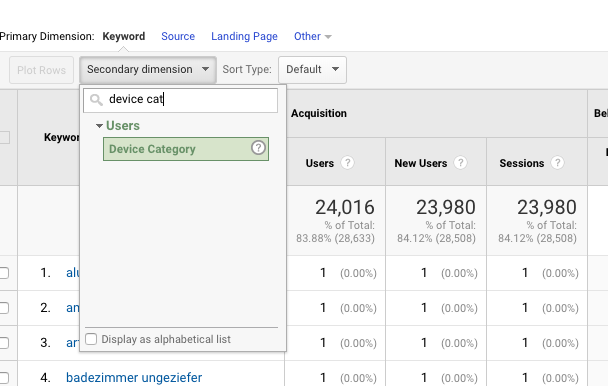Secondary Dimension in Google Analytics: Best Practices and Tips
Secondary Dimension in Google Analytics: Best Practices and Tips
Blog Article
Make Best Use Of Reporting Precision With Second Measurement in Google Analytics
Understanding how to take full advantage of reporting precision with secondary dimensions in Google Analytics can dramatically improve the deepness of insights obtained from information analysis. By integrating secondary measurements purposefully, online marketers can uncover hidden patterns and connections that might not be promptly apparent when analyzing main metrics alone.
Comprehending Second Dimensions in Google Analytics
To enhance information evaluation and gain deeper insights right into customer behavior, recognizing secondary measurements in Google Analytics is essential. Additional measurements enable individuals to segment and additionally study information past the key measurement chosen. By including secondary measurements, analysts can refine their records to reveal even more thorough information regarding customer communications on a site. While the primary measurement may present the total number of web page sights, adding an additional measurement such as 'source/medium' can give insights right into where the traffic originated from. This added layer of details makes it possible for online marketers to evaluate the effectiveness of different advertising projects or channels in driving web traffic to the website.
In addition, recognizing second measurements is vital for developing more personalized reports customized to details service goals. By picking the appropriate combination of additional and key dimensions, experts can discover patterns, fads, and correlations that might otherwise remain surprise. This nuanced approach to information evaluation empowers organizations to make informed decisions based on a thorough understanding of customer habits across numerous dimensions.

Exactly How to Use Second Measurements
When leveraging second dimensions in Google Analytics, the sensible application includes choosing particular information parameters to additional refine insights beyond the main dimension's scope. To use secondary dimensions successfully, begin by accessing the report or dataset where you desire to dive deeper into the information. Remember that second measurements assist give context and granularity to your primary measurement data, allowing you to extract more significant and actionable insights from your Google Analytics records.
Leveraging Second Dimensions for Insights
Using secondary measurements in Google Analytics permits an extra comprehensive analysis of information, supplying beneficial insights beyond the main dimension's scope. By leveraging second measurements, users can delve much deeper right into the performance metrics of their web site or application, revealing covert patterns and trends that may not be right away noticeable when just taking a look at primary dimensions.
One secret benefit of utilizing additional measurements is the ability to section and filter data a lot more specifically. This can assist experts and marketing professionals better comprehend the behavior of particular user segments, such as brand-new visitors versus returning site visitors, or website traffic coming from different geographic you can try this out locations.
Moreover, second dimensions make it possible for users to contrast and contrast various information factors within the very same record, giving a more alternative sight of efficiency (Secondary Dimension in Google Analytics). As an example, coupling the primary measurement of landing web pages with secondary dimensions like demographics or tools can expose which web pages are most reliable in involving individuals on various gadgets or from different market teams.
Basically, leveraging second dimensions in Google Analytics equips customers to draw out richer insights from their information, resulting in more educated decision-making and ultimately, improved performance.
Best Practices for Additional Dimensions
When assessing data in Google Analytics, integrating additional dimensions properly enhances the depth of understandings acquired from the primary metrics. Selecting pertinent secondary measurements aids in providing context and a clearer understanding of the information being examined.
Furthermore, it is advised to limit the variety of secondary dimensions utilized in a solitary record to avoid frustrating the evaluation with too much information. Concentrating on a few crucial second dimensions each time can bring about even more focused and actionable insights. Furthermore, consider try out various mixes of primary and additional dimensions to reveal distinct trends and patterns that may not appear when taking a look at the information in seclusion.
Advanced Analysis Strategies With Additional Dimensions
Exploring intricate information relationships through the critical application of additional dimensions can unveil nuanced understandings that raise the deepness of evaluation in Google Analytics. By Read More Here combining second measurements with primary data sets, innovative analysis techniques can be employed to remove beneficial details. One such strategy is associate evaluation, where second measurements permit the division of customers right into teams sharing usual attributes. This approach makes it possible for a deeper understanding of user behavior patterns over time, helping in the recognition of fads and the evaluation of advertising and marketing campaigns' efficiency.
In addition, secondary measurements can enhance the evaluation of conversion courses by offering added context. Recognizing the various touchpoints an individual connects with before transforming can be important in maximizing the customer trip - Secondary Dimension in Google Analytics. By utilizing additional measurements to explore specifics such as web traffic resources or tools used, online marketers can customize strategies to useful reference target high-converting channels properly
Conclusion

To enhance data analysis and gain deeper understandings right into user behavior, comprehending second measurements in Google Analytics is crucial - Secondary Dimension in Google Analytics. Second measurements allow individuals to section and better dissect data beyond the key measurement selected. While the main measurement might display the complete number of page views, including a secondary dimension such as 'source/medium' can supply insights into where the traffic stemmed from.When leveraging additional dimensions in Google Analytics, the practical application includes picking particular data parameters to further improve insights past the primary dimension's scope. Remember that second measurements aid give context and granularity to your main dimension data, allowing you to remove even more purposeful and workable insights from your Google Analytics records
Report this page